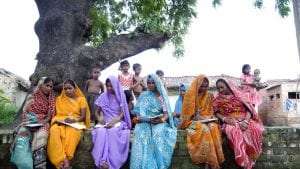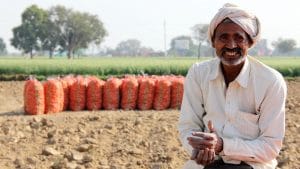‘Digital revolution spurs growth opportunities in rural India, outperforming urban landscape in banking’

KV Prasad Jun 13, 2022, 06:35 AM IST (Published)
 Listen to the Article (6 Minutes)
Listen to the Article (6 Minutes)
Summary
The key driving force behind this trend is the widespread adoption of digital technology, which has transformed the rural economy and opened up new avenues for progress.
In the realm of Indian banking, the growth opportunities in rural and semi-rural areas have become a topic of discussion, with experts highlighting the reasons behind this booming sector and comparing it to urban India’s financial landscape. The key driving force behind this trend is the widespread adoption of digital technology, which has transformed the rural economy and opened up new avenues for progress.
During the PWC CEO Dialogues, Govind Singh, MD & CEO of Utkarsh Small Finance Bank, revealed a significant development — 100 percent of new bank account openings in rural India are now being done digitally. “Which is not the case in places like Mumbai and Delhi,” he informed.
Singh shared that rural India has adopted the technology to the extent possible and believes technology can help bring the operational costs down, which is one of the biggest challenges of the rural economy.
This shift towards digital banking has been enthusiastically embraced by rural communities, leading to increased usage of digital payment systems like UPI and QR codes. Singh emphasised the immense impact this digital revolution is having on the overall Indian economy.
“Rural India has adopted the technology to the extent possible, and the type of UPI use, QR code use has so much increased right now so, that is going to make an immense impact on the Indian economy overall.”
Singh further highlighted the future trajectory of the financial industry in rural India, predicting that wealth management will surpass lending in terms of growth. This trend indicates a changing financial mindset and the emergence of a more prosperous rural middle class.
Singh also discussed the challenges faced by financial institutions when expanding into rural areas with sparse populations. The cost of distribution in large cities tends to be lower due to higher population density.
“In rural India, the population is thinly scattered, leading people to gravitate towards larger cities. Consequently, the cost of distributing goods and services tends to be lower in these urban areas. Moreover, when assessing the return on assets (ROA), microfinance and unsecured lending businesses in such cities demonstrate notably high figures.”
However, Singh emphasised that the cost of delivering banking services in remote areas, such as interior Mao, can be up to five to six times higher than in cities like Varanasi.
“It is worth noting that when discussing preferred destinations, people rarely choose to venture into the remote regions like Mao. In fact, the cost of delivering or distributing goods in Mao is nearly five to six times higher compared to Varanasi.”
To address this issue, Singh emphasised the importance of achieving complete digitalisation, which would significantly reduce distribution costs and improve accessibility for customers in rural areas.
The second aspect mentioned by Singh was the rise of self-entrepreneurs in both urban and rural regions. He observed a growing trend of individuals, particularly in semi-urban and interior areas, expressing a desire to start their own businesses and take risks.
“They possess a strong desire to engage in experimentation and take risks, and this phenomenon is not limited to just Mumbai or Delhi; I am referring to the phenomena that occur in the interior regions. I believe that such circumstances foster an environment conducive to growth through experimentation and enhance people’s capacity for risk-taking.”
Gayathri Parthasarathy, Partner and Leader of Financial Services at PwC India, another participant in the discussion, noted that digital transformation is not limited to banking alone but is prevalent across various sectors throughout the country.
“In terms of the innovations that is coming across in payments, whether it is UPI, UPI lite, or anything else that is happening from a fintech ecosystem, etc. all are leading to in terms of how the disruptive technologies can help the banks to further strengthen and grow.”
Additionally, speaking about the inclusivity of credit, Parthasarathy highlighted the significance of extending financial services to the bottom of the pyramid. She called for further enhancements in this regard, emphasising that rural entrepreneurship is a key driver of growth for India. According to her, fostering and nurturing entrepreneurship in rural areas will contribute significantly to the nation’s overall development.
“What can be done more or what needs to be done more for next, I would definitely say that we have to reach to the last mile. Credit inclusivity needs to come in, in terms of reaching the bottom of the pyramid.”
“At some point in time if you look at India for the growth, you really need, I would call it as rural entrepreneurship that needs to thrive, really truly speaking, and that is what will make the country in terms of growth, fundamentally even higher.”
While rural India thrives, the conversation also touched upon the growth potential in urban India. Ashwini Kumar Tewari, managing director (MD) of State Bank of India (SBI), pointed out that urban financial inclusion remains an underutilised opportunity.
Despite the focus on rural areas, there is a need to cater to the urban population, including those who do not fit the conventional salaried class profile, as India undergoes rapid urbanisation.
Tiwari states that while there has been significant growth in rural areas through digitisation and end-to-end digital solutions for small ticket loans, there is still a considerable untapped opportunity in urban areas that hasn’t yet to fully utilise.
“But I think India is urbanising at a very fast pace and apart from the urban infrastructure, which is a separate category where a lot of opportunity exists, I think we need to take into account that the more and more people coming to cities.”
These individuals often have slightly higher incomes, although they may not fit the traditional salaried employee profile. It is crucial for us to devise strategies to cater to this urban population, whether through a Business Correspondent (BC) model or a Microfinance Institution (MFI) model, he informed.
This represents another significant opportunity that we should seize, he noted.
Prashant Kumar, MD & CEO, YES Bank, highlighted the changing investment patterns in rural India. He noted a considerable increase in systematic investment plans (SIPs) in mutual funds, signaling a shift away from traditional fixed deposits (FDs). “Rural indians are asking if they can invest in global shares, and they don’t even invest in FDs,” he said.
Reflecting on the overall scenario, it becomes evident that the digital revolution is narrowing the gap between rural and urban areas, transforming the economic landscape of India.
This technological leap, combined with factors like rural entrepreneurship and manufacturing potential, has bolstered the growth prospects of rural and semi-rural India.
As rural and semi-rural India continue to embrace technology, digital solutions, and entrepreneurial ventures, the banking and financial sector is witnessing an upward trajectory in these regions.
This presents an optimistic outlook for the sustained growth and prosperity of rural and semi-rural India, making it an increasingly attractive destination for investment and economic development compared to urban areas.

Elon Musk forms several ‘X Holdings’ companies to fund potential Twitter buyout
3 Mins Read
Thursday’s filing dispelled some doubts, though Musk still has work to do. He and his advisers will spend the coming days vetting potential investors for the equity portion of his offer, according to people familiar with the matter

KV Prasad Journo follow politics, process in Parliament and US Congress. Former Congressional APSA-Fulbright Fellow










 Listen to the Article
Listen to the Article  Daily Newsletter
Daily Newsletter
















